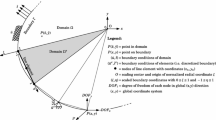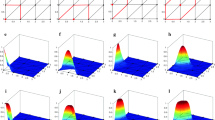Abstract
The Generalized/eXtended Finite Element Method (G/XFEM) is applied as a very useful tool in the resolution of complex structural models using an effective approach to represent the existence of cracks and other micro-defects. This is an unconventional formulation of the Finite Element Method (FEM), in that there is an expansion of the approximate solution field from the use of enrichment functions associated with the nodes. Enrichment functions can be singular functions derived from analytic deductions, polynomial functions or even functions resulting from other solution processes, such as the global–local strategy. The Stable Generalized Finite Method (SGFEM) is a variation of the G/XFEM with a simple modification in its enrichment functions, reducing the condition number of the stiffness matrix as well as the approximate error in the so-called blending elements. Considering this under the global–local strategy, the solution quality and the conditioning of the stiffness matrix in 3D linear fracture problems are investigated here. The crack surface is described by the Heaviside discontinuous functions and singular/crack front functions on a local scale. The solution of the local problem is used to enrich the approximation in the global domain, which may cause bad conditioning of the resulting system of equations and poor approximation errors in the solution. In order to overcome this problem, its projection into the linear polynomial space, according to the SGFEM strategy, is subtracted from the enrichment. Numerical examples, with different load and crack configurations, of linear elastic fracture mechanics are employed. Differently from other works, the meshes of the two scales are kept constant. Only the number of nodes associated with the local enrichment functions is changing. The impact on the accuracy and conditioning of the analysis is assessed, and the importance of using the SGFEM strategy is highlighted.
















Similar content being viewed by others
References
Babuška I, Caloz G, Osborn JE (1994) Special finite element methods for a class of second order elliptic problems with rough coefficients. SIAM J Numer Anal 31:945–981
Duarte CA (1996) The hp cloud method. Ph.D. thesis, University of Texas at Austin, Austin, TX, USA
Babuška I, Melenk JM (1997) The partition of unity finite element method. Int J Numer Methods Eng 40:727–58
Duarte CA, Babuška I, Oden JT (2000) Generalized finite element methods for three-dimensional structural mechanics problems. Comput Struct 77:215–232
Strouboulis T, Babuška I, Copps K (2000) The design and analysis of the generalized finite element method. Comput Methods Appl Mech Eng 181:43–69
Oden JT, Duarte CA (1997) Chapter: Cloud, cracks and fems. In: Recent developments in computational and applied mechanics, pp 302–321
Barros FB, Proença SBP, Barcellos CS (2004) Generalized finite element method in structural nonlinear analysis. Comput Mech 33:95–107
Monteiro AB, Wolenski ARV, Barros FB, Pitangueira RLS, Penna SS (2017) A computational framework for G/XFEM material nonlinear analysis. Adv Eng Softw 114:380–393
Belytschko T, Black T (1999) Elastic crack growth in finite elements with minimal remeshing. Int J Numer Methods Eng 45:601–620
Sukumar N, Moës N, Moran B, Belytschko T (2000) Extended finite element method for three-dimensional crack modelling. Int J Numer Methods Eng 48:1549–1570
Moës N, Belytschko T (2002) Extended finite element method for cohesive crack growth. Eng Fract Mech 69:813–833
Mariani S, Perego U (2003) Extended finite element method for quasi-brittle fracture. Int J Numer Meth Eng 58:103–126
Unger JF, Eckardt S, Könke C (2007) Modelling of cohesive crack growth in concrete structures with the extended finite element method. Comput Methods Appl Mech Eng 196:4087–4100
Belytschko T, Gracie R (2007) On xFEM applications to dislocations and interfaces. Int J Plast 23:1721–1738
Fries TP, Belytschko T (2010) The extended/generalized finite element method: an overview of the method and its applications. Int J Numer Methods Eng 84:253–304
Szabo BA, Babuška I (1988) Computation of the amplitude of stress singular terms for cracks and reentrant corners. In: Cruse TA (ed) Fracture mechanics: nineteenth symposium. ISBN ASTM STP 969
Pereira JP, Duarte CA, Jiao X (2010) Three-dimensional crack growth with hp-generalized finite element and face offsetting methods. Comput Methods Appl Mech Eng 46:431–453
Duarte CA, Kim D-J (2008) Analysis and applications of a generalized finite element method with global-local enrichment functions. Comput Methods Appl Mech Eng 197:487–504
Kim D-J, Pereira JP, Duarte CA (2010) Analysis of three-dimensional fracture mechanics problems: a two-scale approach using coarse-generalized fem meshes. Int J Numer Methods Eng 81:335–365
Malekan M, Barros FB, Pitangueira RLS (2018) Fracture analysis in plane structures with the two-scale G/XFEM method. Int J Solids Struct 155:65–80
Pereira JPA, Duarte CA, Kim D-J (2012) A two-scale approach for the analysis of propagating three-dimensional fractures. Comput Mech 49:99–121
O’Hara P, Duarte CA, Eason T (2016) A two-scale generalized finite element method for interaction and coalescence of multiple crack surfaces. Eng Fract Mech 163:274–302
Li H, Duarte CA (2018) A two-scale generalized finite element method for parallel simulations of spot welds in large structures. Comput Methods Appl Mech Eng 337:28–65
Chessa J, Wang H, Belytschko T (2003) On the construction of blending elements for local partition of unity enriched finite elements. Int J Numer Methods Eng 57:1015–1038
Babuška I, Banerjee U (2012) Stable generalized finite element method (SGFEM). Comput Methods Appl Mech Eng 201:91–111
Gupta V, Duarte CA, Babuška I, Banerjee U (2013) A stable and optimally convergent generalized fem (SGFEM) for linear elastic fracture mechanics. Comput Methods Appl Mech Eng 266:23–39
Gupta V, Duarte CA, Babuška I, Banerjee U (2015) Stable GFEM (SGFEM): improved conditioning and accuracy of GFEM/XFEM for three-dimensional fracture mechanics. Comput Methods Appl Mech Eng 289:355–386
Oliveira TS, Barros FB, Fonseca GM, Pitangueira RLS (2019) 2-D fracture mechanics problems by SGFEM. Eng Anal Bound Elem 108:279–294
Malekan M, Barros FB (2016) Well-conditioning global-local analysis using stable generalized/extended finite element method for linear elastic fracture mechanics. Comput Mech 58:819–831
Zhang Q, Banerjee U, Babuška I (2014) Higher order stable generalized finite element method. Numer Math 128:1–29
Wu J-Y, Li F-B (2015) An improved stable xFEM (IS-xFEM) with a novel enrichment function for the computational modeling of cohesive cracks. Comput Methods Appl Mech Eng 295:77–107
Zhang Q, Babuška I, Banerjee U (2016) Robustness in stable generalized finite element methods (SGFEM) applied to Poisson problems with crack singularities. Comput Methods Appl Mech Eng 311:476–502
Sato FM, Neto DP, Proenca SPB (2018) Numerical experiments with the generalized finite element method based on a flat-top partition of unity. Latin Am J Solids Struct 15:e65–1
Zhang Q, Banerjee U, Babuška I (2019) Strongly stable generalized finite element method (SSGFEM) for a non-smooth interface problem. Comput Methods Appl Mech Eng 344:538–568
Sanchez-Rivadeneira A, Duarte CA (2019) A stable generalized/extended fem with discontinuous interpolants for fracture mechanics. Comput Methods Appl Mech Eng 345:876–918
Fonseca FT, Pitangueira RLS (2007) An object oriented class organization for dynamic geometrically nonlinear fem analysis. Iberian Latin American Congress on Computational Methods in Engineering - CILAMCE, Belém, PA, Brazil
Alves PD, Barros FB, Pitangueira RLS (2013) An object-oriented approach to the generalized finite element method. Adv Eng Softw 59:1–18
Malekan M, Barros FB, Pitangueira RLS, Alves PD, Penna SS (2017) A computational framework for a two-scale generalized/extended finite element method. Eng Comput 34:988–1019
dos Santos Karla Fernanda (2018) Método dos elementos finitos generalizados aplicado a problemas de fratura elástica em 3d. Master’s thesis, Universidade Federal de Minas Gerais, Belo Horizonte, MG, Brasil, Março
Gupta V (2014) Improved conditioning and accuracy of a two-scale generalized finite element method for fracture mechanics. Ph.D. thesis, University of Illinois at Urbana-Champaign, Urbana, Illinois, USA
Oden JT, Reddy JN (2011) An introduction to the mathematical theory of the finite element method. Dover, Mineola
Moës N, Dolbow J, Belytschko T (1999) A finite element method for crack growth without remeshing. Int J Numer Methods Eng 46:131–150
Gupta P, Pereira JP, Kim D-J, Duarte CA, Eason T (2012a) Analysis of three-dimensional fracture mechanics problems: a non-intrusive approach using a generalized finite element method. Eng Fract Mech 90:41–64
Park K, Pereira JP, Duarte CA, Paulino GH (2009) Integration of singular enrichment functions in the generalized/extended finite element method for three-dimensional problems. Int J Numer Methods Eng 78:1220–1257
Alves, Phillipe Daniel (2012) Estratégia global-local aplicada ao método dos elementos finitos generalizados. Master’s thesis, Universidade Federal de Minas Gerais, Belo Horizonte, MG, Brasil, Maio
Gupta V, Kim D-J, Duarte CA (2012b) Analysis and improvements of global-local enrichments for the generalized finite element method. Comput Methods Appl Mech Eng 245–246:47–62
Acknowledgements
The authors are grateful for financial support in the form of research support granted by the Conselho Nacional de Desenvolvimento Científico e Tecnológico (CNPq) (Grants 437639/2018-5 and 304211/2019-2) and by the Fundação de Amparo à Pesquisa do Estado de Minas Gerais (FAPEMIG) (master’s degree).
Author information
Authors and Affiliations
Corresponding author
Additional information
Technical Editor: João Marciano Laredo dos Reis.
Publisher's Note
Springer Nature remains neutral with regard to jurisdictional claims in published maps and institutional affiliations.
Rights and permissions
About this article
Cite this article
Santos, K.F., Barros, F.B. SGFEM: a numerical investigation of the two-scale simulation of 3D elastic fracture. J Braz. Soc. Mech. Sci. Eng. 42, 305 (2020). https://doi.org/10.1007/s40430-020-02394-3
Received:
Accepted:
Published:
DOI: https://doi.org/10.1007/s40430-020-02394-3




